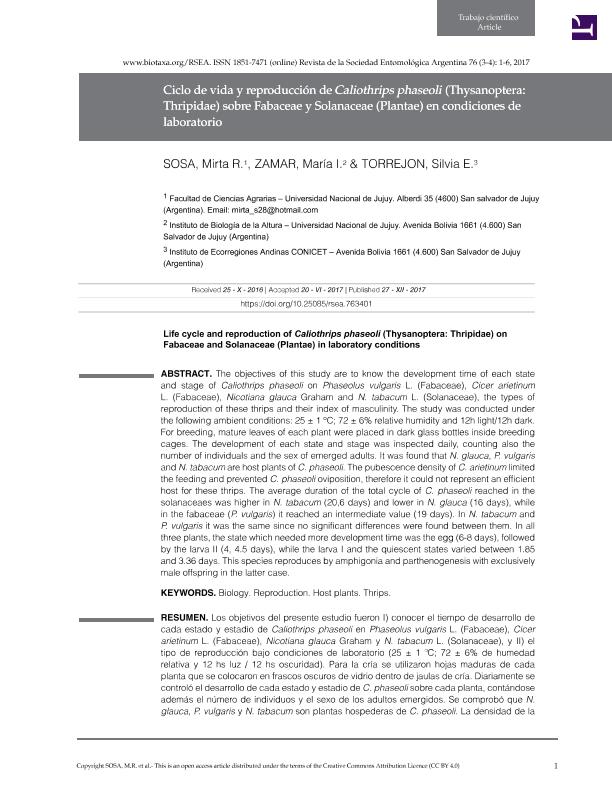Artículo
Los objetivos del presente estudio fueron I) conocer el tiempo de desarrollo decada estado y estadio de Caliothrips phaseoli en Phaseolus vulgaris L. (Fabaceae), Cicerarietinum L. (Fabaceae), Nicotiana glauca Graham y N. tabacum L. (Solanaceae), y II) el tipo de reproducción bajo condiciones de laboratorio (25 ± 1 ºC; 72 ± 6% de humedad relativa y 12 hs luz / 12 hs oscuridad). Para la cría se utilizaron hojas maduras de cada planta que se colocaron en frascos oscuros de vidrio dentro de jaulas de cría. Diariamente se controló el desarrollo de cada estado y estadio de C. phaseoli sobre cada planta, contándose además el número de individuos y el sexo de los adultos emergidos. Se comprobó que N. glauca, P. vulgaris y N. tabacum son plantas hospederas de C. phaseoli. La densidad de la pubescencia de C. arietinum limitó la alimentación e impidió la oviposición de C. phaseoli, por lo que no representaría una planta hospedera eficiente para este trips. La duración promedio del ciclo total de C. phaseoli alcanzado en las solanáceas fue mayor en N. tabacum (20,6 días) y menor en N. glauca (16 días), mientras que en la fabácea (P. vulgaris) alcanzó un valor intermedio (19 días). En N. tabacum y P. vulgaris fue la misma ya que no se encontraron diferencias significativas entre ella. En las tres especies vegetales, el estado que necesitó más tiempo de desarrollo fue el de huevo (6-8 días), seguido por el de larva II (4 - 4,5 días), mientras que la larva I y los estados quiescentes variaron entre 1,85 y 3,36 días. Esta especie se reproduce por anfigonia y partenogénesis con descendencia exclusiva de machos en esteúltimo caso. The objectives of this study are to know the development time of each state and stage of Caliothrips phaseoli on Phaseolus vulgaris L. (Fabaceae), Cicer arietinum L. (Fabaceae), Nicotiana glauca Graham and N. tabacum L. (Solanaceae), the types of reproduction of these thrips and their index of masculinity. The study was conducted under the following ambient conditions: 25 ± 1 °C; 72 ± 6% relative humidity and 12h light/12h dark.For breeding, mature leaves of each plant were placed in dark glass bottles inside breeding cages. The development of each state and stage was inspected daily, counting also the number of individuals and the sex of emerged adults. It was found that N. glauca, P. vulgaris and N. tabacum are host plants of C. phaseoli. The pubescence density of C. arietinum limited the feeding and prevented C. phaseoli oviposition, therefore it could not represent an efficient host for these thrips. The average duration of the total cycle of C. phaseoli reached in the solanaceaes was higher in N. tabacum (20,6 days) and lower in N. glauca (16 days), while in the fabaceae (P. vulgaris) it reached an intermediate value (19 days). In N. tabacum and P. vulgaris it was the same since no significant differences were found between them. In all three plants, the state which needed more development time as the egg (6-8 days), followed by the larva II (4, 4.5 days), while the larva I and the quiescent states varied between 1.85 and 3.36 days. This species reproduces by amphigonia and parthenogenesis with exclusively male offspring in the latter case.
Ciclo de vida y reproducción de Caliothrips phaseoli (Thysanoptera: Thripidae) sobre Fabaceae y Solanaceae (Plantae) en condiciones de laboratorio
Título:
Life cycle and reproduction of Caliothrips phaseoli (Thysanoptera: Thripidae) on Fabaceae and Solanaceae (Plantae) in laboratory conditions
Fecha de publicación:
27/11/2017
Editorial:
Sociedad Entomológica Argentina
Revista:
Revista de la Sociedad Entomológica Argentina
ISSN:
0373-5680
e-ISSN:
1851-7471
Idioma:
Español
Tipo de recurso:
Artículo publicado
Clasificación temática:
Resumen
Palabras clave:
Biología
,
Reproducción
,
Plantas Hospedadoras
,
Trips
Archivos asociados
Licencia
Identificadores
Colecciones
Articulos(INECOA)
Articulos de INSTITUTO DE ECORREGIONES ANDINAS
Articulos de INSTITUTO DE ECORREGIONES ANDINAS
Citación
Sosa, Mirta R.; Zamar, María Inés; Torrejon, Silvia Elena; Ciclo de vida y reproducción de Caliothrips phaseoli (Thysanoptera: Thripidae) sobre Fabaceae y Solanaceae (Plantae) en condiciones de laboratorio; Sociedad Entomológica Argentina; Revista de la Sociedad Entomológica Argentina; 76; 3-4; 27-11-2017; 1-6
Compartir
Altmétricas




